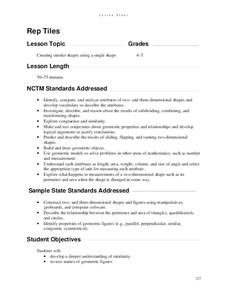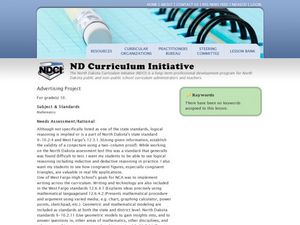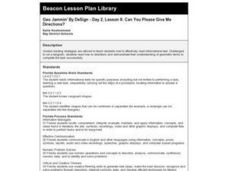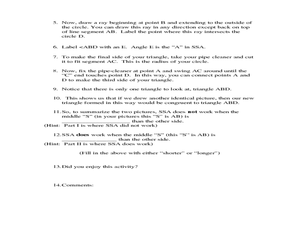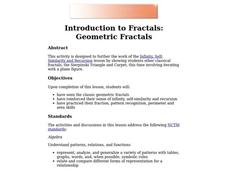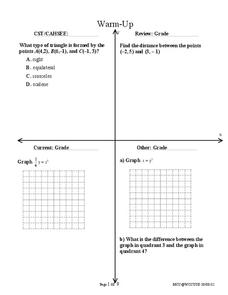EngageNY
Mid-Module Assessment Task: Grade 8 Module 2
It's time for a concept check! Check for student understanding over the three types of rigid transformations. The assessment follows the first 10 lessons in this series and to test pupils' proficiency of these concepts. Individuals...
EngageNY
How Do Dilations Map Angles?
The key to understanding is making connections. Scholars explore angle dilations using properties of parallel lines. At completion, pupils prove that angles of a dilation preserve their original measure.
Improving Measurement and Geometry in Elementary Schools
Rep Tiles
In addition to the catchy title, this lesson plan provides upper graders an opportunity to more closely scrutinize the attributes of plane figures. In particular, they focus on the similarity of different shapes. Both whole-class and...
Annenberg Foundation
Geometry 3D Shapes: Platonic Solids
From polyhedrons to platonic solids, here is a lesson that will have your classes talking! As an introduction to platonic solids, scholars cut and fold nets to create the three-dimensional solids. They use an interactive component to...
Curated OER
Exploring and Using Shapes to Make a Dance
Second graders use their bodies to create various shapes to make a dance when given various music and beats. In this shapes and dance lesson plan, 2nd graders create lines, curves, twists, and angles with their bodies.
Curated OER
How Many Regular Polyhedrons Are There In This or Any Universe?
Students examine the idea of "regularity" as it pertains to geometry. In this geometry lesson students complete several assignments that are part of trihedral angles and regular polyhedrons.
Curated OER
Pythagorean Theorem
Students explore how the Pythagorean Theorem works and how to apply it.
Curated OER
SAS Similarity Theorem
Students identify and use the similarity theorem. In this geometry lesson, students differentiate between congruent and similar triangles. They solve problems using the computer modifying shapes by dragging.
Curated OER
Simson Line
Stuednts identify triangles for the Simson Line. For this geometry lesson, students solve triangular problems using the properties of triangles.They differentiate between the height, congruency and similarity.
Curated OER
Deductive and Inductive Reasoning
Students differentiate between inductive and deductive reasoning. For this geometry lesson, students identify congruent figures and examine logos for congruency.
Curated OER
Functions
Fifth graders explore mathematics functions. For this functions lesson, 5th graders explore 1 and 2-step functions involving addition, subtraction, multiplication, and division. Students also practice solving problems that their...
Curated OER
Relative Size Lesson Plan for First Grade
First graders compare triangle sizes, square sizes, and lengths. They use manipulatives of three varied sized triangles, squares, and strips to measure and compare relative size and length.
Curated OER
Geo Jammin' By DeSign - Day 1, Lesson 2: Dancing Duo
Second graders and teachers identify geometric vocabulary word by searching a geometry website. They create a Quilt Word Wall using the geometry words.
Curated OER
Geo Jammin' By DeSign - Day 2, Lesson 8: Can You Please Give Me Directions?
Students participate in a guided reading experience by following directions to cut out tangrams. They listen to the directions and cut as the reading progresses.
Curated OER
Geo Jammin' By DeSign - Day 1, Lesson 1: Math in Motion
Second graders, through large screen monitor, study geometric design. They participate in a diagnostic assessment in which they use pnecils, scissors and paste.
Curated OER
Why Doesn't SSA Work?
Students investigate the relationship between angles and their sides. In this geometry instructional activity, students prove why SSA does not work as a true angle side relationship theorem.
Curated OER
Introduction to Fractals: Geometric Fractals
Students study and observe the patterns made by the areas of the Sierpinski Triangle. Students use the computer to draw two or three iterations to discover the number patterns. Students complete worksheets based on Geometric Fractals.
Curated OER
Grade 5: Testing for Tessellations
Fifth graders use formal geometric language to describe polygons (and other shapes) that will tessellate the plane and those that will not. Students make generalizations about the characteristics of a polygon (or other shape) that will...
Curated OER
Angling Your Way Through a Picture
Learners look at the geometry in an artwork. In this art history/geometry lesson, students research the artist Charles Sheeler and look at his painting Stacks in Celebration. They find the different types of lines, angles, and...
EngageNY
General Pyramids and Cones and Their Cross-Sections
Are pyramids and cones similar in definition to prisms and cylinders? By examining the definitions, pupils determine that pyramids and cones are subsets of general cones. Working in groups, they continue to investigate the relationships...
West Contra Costa Unified School District
Conics Introduction and Parabolas
Where did conic sections get their name? The equation and graph of a parabola are developed from the definition of the conic section. Teacher examples on graphing the equation and writing an equation from the graph round out the plan.
Curated OER
Arts Impact and Math
Third graders incorporate math into dancing. In this algebra lesson, 3rd graders identify different shapes and patterns using dance movements. They relate the different creations to polygons as they incorporate the use of stretchy bands...
Curated OER
Attributes of Polygons: Stretchy Shapes
Fourth graders use dancing methodology in a polygon and shape activity. In this shape and dance instructional activity, 4th graders discuss shapes in dance, math, and everyday life. Students use dancing activities to recognize and...
Improving Measurement and Geometry in Elementary Schools
The Sum of the Interior Angles of a Polygon
Junior geometers discover that polygons can be decomposed into triangles and that the number of triangles can be determined by a rule. Note that the Geometer’s Sketchpad® software is required to carry out all components of this...




